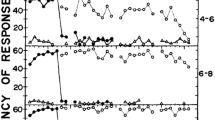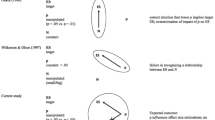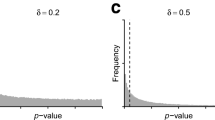Abstract
Researchers continue to recommend that applied behavior analysts use inferential statistics in making decisions about effects of independent variables on dependent variables. In many other approaches to behavioral science, inferential statistics are the primary means for deciding the importance of effects. Several possible uses of inferential statistics are considered. Rather than being an objective means for making decisions about effects, as is often claimed, inferential statistics are shown to be subjective. It is argued that the use of inferential statistics adds nothing to the complex and admittedly subjective nonstatistical methods that are often employed in applied behavior analysis. Attacks on inferential statistics that are being made, perhaps with increasing frequency, by those who are not behavior analysts, are discussed. These attackers are calling for banning the use of inferential statistics in research publications and commonly recommend that behavioral scientists should switch to using statistics aimed at interval estimation or the method of confidence intervals. Interval estimation is shown to be contrary to the fundamental assumption of behavior analysis that only individuals behave. It is recommended that authors who wish to publish the results of inferential statistics be asked to justify them as a means for helping us to identify any ways in which they may be useful.
Similar content being viewed by others
References
Abelson, R. P. (1997). On the surprising longevity of flogged horses: Why there is a case for the significance test. Psychological Science, 8, 12–15.
Atkinson, D. R., Furlong, M. J., & Wampold, B. E. (1982). Statistical significance, reviewer evaluations, and the scientific process: Is there a (statistically) significant relationship? Journal of Counseling Psychology, 29, 189–194.
Baer, D. M. (1977). Perhaps it would be better not to know everything. Journal of Applied Behavior Analysis, 10, 167–172.
Bakan, D. (1966). The test of significance in psychological research. Psychological Research, 66, 423–437.
Barlow, D. H. (Ed.). (1983). Journal of Applied Behavior Analysis, 16(2, 3).
Bernard, C. (1927). An introduction to the study of experimental medicine. New York: Macmillan. (Original work published 1865)
Branch, M. N. (Ed.). (1993). Journal of the Experimental Analysis of Behavior, 60.
Cohen, J. (1990). Things I have learned (so far). American Psychologist, 45, 1304–1312.
Cohen, J. (1994). The earth is round (p <.05). American Psychologist, 49, 997–1003.
Cooper, J. O., Heron, T. E., & Heward, W. L. (1987). Applied behavior analysis. Columbus, OH: Merrill.
Costa, L., & Rourke, B. P. (Eds.). (1994). Journal of Clinical and Experimental Neuropsychology, 16(1).
DeRouen, T. A. (1987). Comment on statistical testing and confidence intervals. American Journal of Public Health, 77, 237.
Doob, L. W. (Ed.). (1994). Journal of Social Psychology, 134(4).
Dugbartey, A. T. (1994). The factor structure of traditional beliefs among Ghanian university students. Journal of Social Psychology, 134, 549–550.
Edgington, E. S. (1980). Random assignment and statistical tests for one-subject experiments. Behavioral Assessment, 2, 19–28.
Edgington, E. S. (1982). Non-parametric tests for single-subject multiple schedule experiments. Behavioral Assessment, 4, 83–91.
Fisher, R. A. (1925). Statistical methods for research workers. Edinburgh, Scotland: Oliver and Boyd.
Fleiss, J. L. (1986). Significance tests have a role in epidemiologic research: Reactions to A. M. Walker. American Journal of Public Health, 76, 559–560.
Gentile, J. R., Roden, A. H., & Klein, R. D. (1972). An analysis of variance model for the intrasubject replication design. Journal of Applied Behavior Analysis, 5, 193–198.
Gigerenzer, G., & Murray, D. J. (1987). Cognition as intuitive statistics. Hillsdale, NJ: Erlbaum.
Gottman, J. M. (1981). Time-series analysis: A comprehensive introduction for social scientists. Cambridge, England: Cambridge University Press.
Gottman, J. M., & Glass, G. V. (1978). Analysis of interrupted time-series experiments. In T. R. Kratochwill (Ed.), Single-subject research: Strategies for evaluating change (pp. 197–235). New York: Academic Press.
Hartmann, D. P. (1974). Forcing square pegs into round holes: Some comments on “An analysis of variance model for the intrasubject replication design.” Journal of Applied Behavior Analysis, 7, 635–638.
Hartmann, D. P., Gottman, J. M., Jones, R. R., Gardner, W., Kazdin, A. E., & Vaught, R. (1980). Interrupted time-series analysis and its application to behavioral data. Journal of Applied Behavior Analysis, 13, 543–559.
Hays, W. L. (1963). Statistics for psychologists. New York: Holt, Rinehart, and Winston.
Hogben, L. (1957). Statistical theory: The relationship of probability, credibility, and error: An examination of the contemporary crisis in statistical theory from a behaviourist viewpoint. London: Allen and Unwin.
Horne, G. P., Yang, M. C. K., & Ware, W. B. (1982). Time-series analysis for single-subject designs. Psychological Bulletin, 91, 178–189.
Howell, D. C. (1992). Statistical methods for psychology (3rd ed.). Boston: PWS-Kent.
Huitema, B. E. (1986). Statistical analysis and single-subject designs. In A. Poling & R. W. Fuqua (Eds.), Research methods in applied behavior analysis (pp. 209–232). New York: Plenum.
Hulse, S. H. (Ed.). (1994). Journal of Experimental Psychology: Animal Behavior Processes, 20(3).
Hunt, E. (Ed.). (1994). Journal of Experimental Psychology: General, 123(2).
Hunter, J. E. (1997). Needed: A ban on the significance test. Psychological Science, 8, 3–7.
Hurlburt, R. T. (1994). Comprehending behavioral statistics. Pacific Grove, CA: Brooks/Cole.
Johnston, J. M., & Pennypacker, H. S. (1993). Strategies and tactics of behavioral research (2nd ed.). Hillsdale, NJ: Erlbaum.
Jones, R. R., Vaught, R. S., & Weinrott, M. (1977). Time-series analysis in operant research. Journal of Applied Behavior Analysis, 10, 151–166.
Kazdin, A. E. (1976). Statistical analyses for single-case experimental designs. In M. Hersen & D. H. Barlow (Eds.), Single-case experimental designs: Strategies for studying behavior change (pp. 265–316). Oxford, England: Pergamon Press.
Keselman, H. J., & Leventhal, L. (1974). Concerning the statistical procedures enumerated by Gentile et al.: Another perspective. Journal of Applied Behavior Analysis, 7, 643–645.
Kratochwill, T. (Ed.). (1974). Single-subject research: Strategies for evaluating change. New York: Academic Press.
Kratochwill, T., Alden, K., Demuth, D., Dawson, D., Panicucci, C., Arnston, P., McMurray, N., Hemstead, J., & Levin, J. (1974). A further consideration in the application of an analysis of variance model for the intrasubject replication design. Journal of Applied Behavior Analysis, 7, 629–633.
Kratochwill, T., & Levin, J. R. (1980). On the applicability of various data analysis procedures to the simultaneous and alternating treatment designs in behavior therapy research. Behavioral Assessment, 2, 353–360.
Lachenbruch, P. A., Clark, V. A., Cumberland, W. G., Chang, P. C., Afifi, A. A., Flack, V. F., & Elashoff, R. M. (1987). Comment on statistical testing and confidence intervals. American Journal of Public Health, 77, 237.
Levin, J. R. (Ed.). (1994). Journal of Educational Psychology, 86(3).
Mainstone, L. E., & Levi, A. S. (1987). Fundamentals of statistical process control. Journal of Organizational Behavior Management, 9, 5–21.
Meehl, P. E. (1978). Theoretical risks and tabular asterisks: Sir Karl, Sir Ronald and the slow progress of soft psychology. Journal of Consulting and Clinical Psychology, 46, 806–834.
Michael, J. (1974). Statistical inference for individual organism research: Mixed blessing or curse? Journal of Applied Behavior Analysis, 7, 647–653.
Neef, N. A. (Ed.). (1993). Journal of Applied Behavior Analysis, 26(2, 3).
Nevin, J. A. (Ed.). (1983). Journal of the Experimental Analysis of Behavior, 40.
Notz, W. W., Boschman, I., & Tax, S. T. (1987). Reinforcing punishment and extinguishing reward: On the folly of OBM without SPC. Journal of Organizational Behavior Management, 9, 33–46
Parsonson, B. S., & Baer, D. M. (1986). The graphic analysis of data. In A. Poling & R. W. Fuqua (Eds.), Research methods in applied behavior analysis (pp. 157–186). New York: Plenum.
Pfadt, A., Cohen, I. L., Sudhalter, V., Romanczyk, R. G., & Wheeler, D. J. (1992). Applying statistical process control to clinical data: An illustration. Journal of Applied Behavior Analysis, 25, 551–560.
Pfadt, A., & Wheeler, D. J. (1995). Using statistical process control to make data-based clinical decisions. Journal of Applied Behavior Analysis, 28, 349–370.
Poole, C. (1987). Beyond the confidence interval. American Journal of Public Health, 77, 195–199.
Rayner, K. (Ed.). (1994). Journal of Experimental Psychology: Learning, Memory, and Cognition, 20(5).
Rosnow, R. L., & Rosenthal, R. (1988). Focused tests of significance and effect size estimation in counseling psychology. Journal of Counseling Psychology, 35, 203–208.
Rosnow, R. L., & Rosenthal, R. (1989). Statistical procedures and the justification of knowledge in psychological science. American Psychologist, 44, 1276–1284.
Rozeboom, W. W. (1960). The fallacy of the null-hypothesis significance test. Psychological Bulletin, 57, 416–428.
Savitz, D. (1987). Comment on statistical testing and confidence intervals. American Journal of Public Health, 77, 237–238.
Schmitt, N. (Ed.). (1994). Journal of Applied Psychology, 79(3).
Sedlmeier, P., & Gigerenzer, G. (1989). Do studies of statistical power have an effect on the power of studies? Psychological Bulletin, 105, 309–316.
Shrot, P. E. (1997). Should significance tests be banned? Introduction to a special section exploring the pros and cons. Psychological Science, 8, 1–2.
Sidman, M. (1960). Tactics of scientific research. New York: Basic Books.
Somerville, S. C. (Ed.). (1994). Child Development 65(3).
Spence, J. T., Cotton, J. W., Underwood, B. J., & Duncan, C. P. (1990). Elementary statistics (5th ed.). Englewood Cliffs, NJ: Prentice Hall.
Thompson, W. D. (1987). Statistical criteria in the interpretation of epidemiologic data. American Journal of Public Health, 77, 191–194.
Thoresen, C. E., & Elashoff, J. D. (1974). “An analysis-of-variance model for intrasubject replication design”: Some additional comments. Journal of Applied Behavior Analysis, 7, 639–641.
Van Meter, P., Yokoi, L., & Pressley, M. (1994). College students’ theory of note taking derived from their perceptions of note-taking. Journal of Educational Psychology, 86, 323–338.
Walker, A. M. (1986). Reporting the results of epidemiologic studies. American Journal of Public Health, 76, 556–558.
Williams, D. G. (1994). Population density and mental illness. Journal of Social Psychology, 134, 545–546.
Wolff, A. B., Sass, K. J., & Keidan, J. (1994). Case report of an intracarotid amobarbital procedure performed for a deaf patient. Journal of Clinical and Experimental Neuropsychology, 16, 15–20.
Author information
Authors and Affiliations
Additional information
The initial draft of this manuscript was written while the first author was on a sabbatical hosted by the Department of Psychology at Emory University.
Rights and permissions
About this article
Cite this article
Hopkins, B.L., Cole, B.L. & Mason, T.L. A Critique of the Usefulness of Inferential Statistics in Applied Behavior Analysis. BEHAV ANALYST 21, 125–137 (1998). https://doi.org/10.1007/BF03392787
Published:
Issue Date:
DOI: https://doi.org/10.1007/BF03392787




